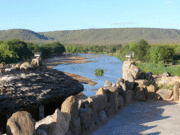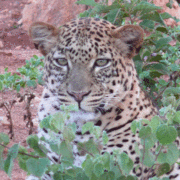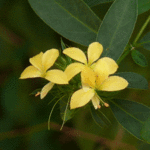TREE WATCH: The ever-changing trees of Kulafumbi > November 2007 Tree Watch (49)
-
Airstrip Baobab 01 (01 Nov 07)
One of the many large Baobab trees near the airstrip on the neighbouring property to us - this one to the left as you stand on the airstrip facing the river. News from this day...
BAOBAB
adansonia digitata
Local names:Swahili: Mbuyu; Maasai: Ol-mesera
Uses: Leaves used as vegetable. Fruit contains dark brown seeds enclosed in edible white pulp, containing tartaric acid - can be soaked in water to make refreshing drink. Red dye obtained from roots. Fibrous bark used for weaving and making ropes.
Traditional Medicine: Drink made from fruit pulp used to treat fevers & diarrhoea; bark and leaves allegedly have anti-inflamatory & diaphoretic properties; boiled bark used as cure for body pains; leaves used in treatment of fever and as an astringent. -
Airstrip Baobab 02 (01 Nov 07)
Another of the many large Baobab trees near the airstrip on the neighbouring property to us - this one to the left as you stand on the airstrip facing the river. You can see how the tree's foliage has turned bright green with the damp conditions. News from this day... -
Airstrip Baobab 03 (01 Nov 07)
The giant Baobab tree at the top end of the airstrip on the neighbouring property to ours - where you can always see at least one or two pairs of Black Headed Plovers, which are dry-country birds (in contrast to the Spurwing Plovers which we have on the river.) News from this day... -
Airstrip Baobab 04 (01 Nov 07)
A young Baobab, in glorious green leaf, stands against the Yatta Plateau - taken from the airstrip on the neighbouring property to ours (on the left as you face the river). News from this day... -
Airstrip Baobab 05 (01 Nov 07)
Another of the many large Baobab trees near the airstrip on the neighbouring property to us - this one also on the left as you stand on the airstrip facing the river. News from this day... -
Baobab across River (02 Nov 07)
This large Baobab can be seen across the river from our house. News from this day... -
-
Small Baobab with Dried Flowers (14 Nov 07)
This small Baobab, on our property - beyond the 'Little Serengeti' and to the right of the road leading from the house - is sporting its gorgeous drying flowers...what an incredible shade of deep red. The flowers in death are almost as beautiful as they are in full bloom. The Baobabs usually flower before they come into leaf (although, having said that, this month we have seen some trees with both flowers in full bloom and leaves...there always seems to be an exception to every rule.) More news from this day... -
Fig Tree opposite house (03 Nov 07)
This is the Fig Tree which we look out onto from the house - just over the river from us. It always looks gorgeous in the golden evening light, which highlights the yellow bark, and the bright green leaves. A favourite of the Orange Bellied Parrots and the Baboons - especially when fruiting, of course. News from 3rd November 2007... -
-
Yellow Barked Acacia above Hippo Bend
This is the young Yellow Fever Tree (aka the Naivasha Thorn), acacia xanthophloea , which is growing just upstream from Hippo Bend - it looks spectacular in the late evening light. This is the same type of tree we have planted next to our birdbath.
These trees were named Fever Trees by early settlers because they always got sick from malaria when staying near these trees, and thought it was the trees that made them ill. In fact, the reason for this is that both these trees and mosquitoes (which carry the malaria) favour wet environments, so that is why the settlers (who no doubt were attraced to the water too) always contracted malaria when near these trees.
FEVER TREE (or NAIVASHA THORN)
acacia xanthophloea
Local names:Swahili: Mgunga; Maasai: Olerai; Kikuyu: Murera
Uses: Much favoured as bee forage - good honey. Foliage & pods used as fodder; wood as fuel & timber for poles & fence posts.
Traditional Medicine: Bark rolled into small ball & chewed to treat coughs & sore throats. -
-
-
-
The Dam Road Baobab (22 Nov 07)
In full leaf, the large Baobab tree which stands on the right of the road to the dam, just as the road starts to turn down towards the river. Read more news from today... -
Elephant Scarring on Dam Road Baobab (22 Nov 07)
You can clearly see how feeding elephants, in years gone by, have scarred this tree. The elephants use their tusks to gouge off the bark - it must contain some minerals which the elephants need in their diet. The Baobab is one of the few trees which can be completely ring-barked (whether by elephants or by man) and still survive. Read more news from today... -
Close-up of Baobab scarring (22 Nov 07)
A close-up view of the scarring caused by previous generations of elephants as they fed on this Baobab's bark. Read more news from today... -
Terminalia Grove - top road to property (22 Nov 07)
There is a grove of Terminalia Orbicularis trees on the top road leading to our property - photographed here in full leaf and glorious evening light. Read more news from today... -
Terminalia in close-up (22 Nov 07)
Close-up of Terminalia thicket in evening light. Read more news from today... -
Terminalia Tree with red pods (26 Nov 07)
The terminalia orbicularis trees on the Kamunyu road are already seeding - they seem to be ahead of the trees on our property, although they are only a few kilometres away. The pinky-red pods are the most amazing sight backlit in the late afternoon sunshine, the "wings" on each seed almost luminescent. More news from today... -
-
-
Terminalia Pods in close-up (26 Nov 07)
Even more beautiful in close-up...More news from today... -
-
-
-
-
-
-
-
-
-
-
-
-
-
-
-
-
-
-
Giant Acacia Elatior (30 Nov 07)
The massive Acacia Elatior in the 'old campsite' - a venerable old tree, which houses a staggering variety of birds. Tales from 30th November 2007... -
-
-
-
-
-
-





